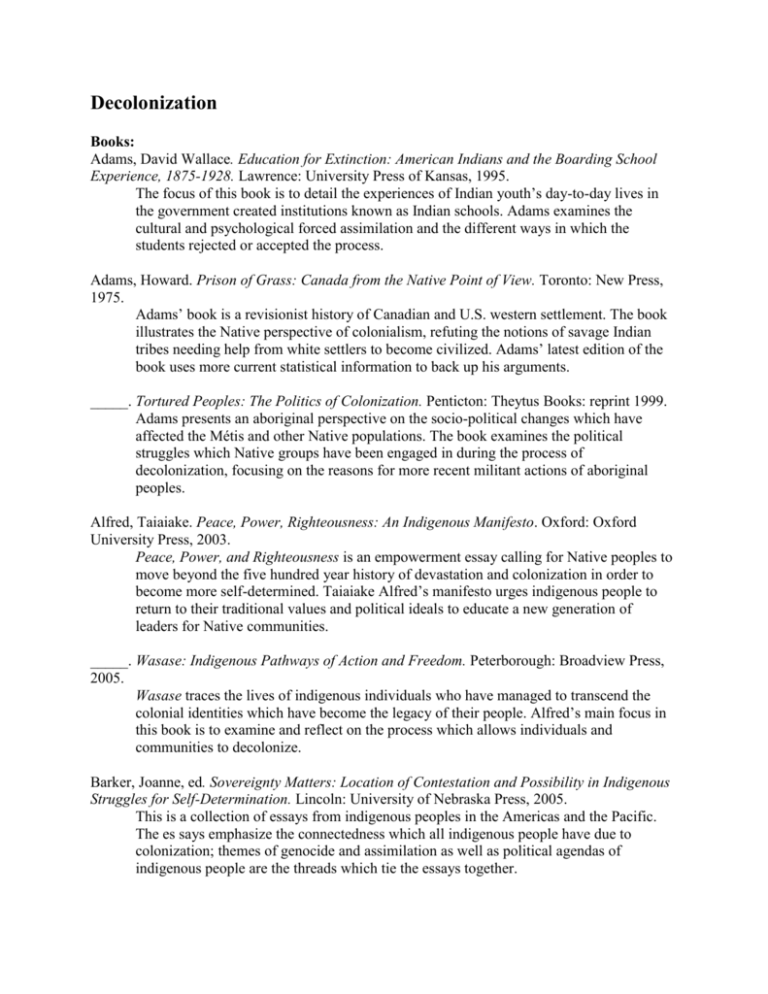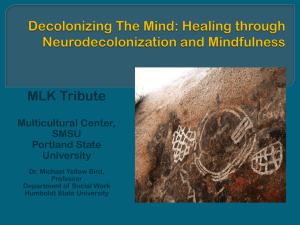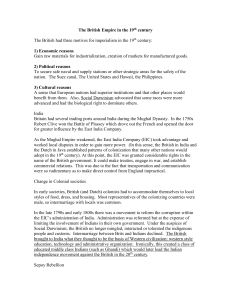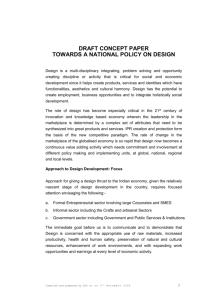Decolonization - School of Historical, Philosophical and Religious
advertisement

Decolonization Books: Adams, David Wallace. Education for Extinction: American Indians and the Boarding School Experience, 1875-1928. Lawrence: University Press of Kansas, 1995. The focus of this book is to detail the experiences of Indian youth’s day-to-day lives in the government created institutions known as Indian schools. Adams examines the cultural and psychological forced assimilation and the different ways in which the students rejected or accepted the process. Adams, Howard. Prison of Grass: Canada from the Native Point of View. Toronto: New Press, 1975. Adams’ book is a revisionist history of Canadian and U.S. western settlement. The book illustrates the Native perspective of colonialism, refuting the notions of savage Indian tribes needing help from white settlers to become civilized. Adams’ latest edition of the book uses more current statistical information to back up his arguments. _____. Tortured Peoples: The Politics of Colonization. Penticton: Theytus Books: reprint 1999. Adams presents an aboriginal perspective on the socio-political changes which have affected the Métis and other Native populations. The book examines the political struggles which Native groups have been engaged in during the process of decolonization, focusing on the reasons for more recent militant actions of aboriginal peoples. Alfred, Taiaiake. Peace, Power, Righteousness: An Indigenous Manifesto. Oxford: Oxford University Press, 2003. Peace, Power, and Righteousness is an empowerment essay calling for Native peoples to move beyond the five hundred year history of devastation and colonization in order to become more self-determined. Taiaiake Alfred’s manifesto urges indigenous people to return to their traditional values and political ideals to educate a new generation of leaders for Native communities. _____. Wasase: Indigenous Pathways of Action and Freedom. Peterborough: Broadview Press, 2005. Wasase traces the lives of indigenous individuals who have managed to transcend the colonial identities which have become the legacy of their people. Alfred’s main focus in this book is to examine and reflect on the process which allows individuals and communities to decolonize. Barker, Joanne, ed. Sovereignty Matters: Location of Contestation and Possibility in Indigenous Struggles for Self-Determination. Lincoln: University of Nebraska Press, 2005. This is a collection of essays from indigenous peoples in the Americas and the Pacific. The es says emphasize the connectedness which all indigenous people have due to colonization; themes of genocide and assimilation as well as political agendas of indigenous people are the threads which tie the essays together. Bruchac, Margaret, Siobhan Hart and H. Martin Wobst, eds. Indigenous Archaeologies: A Reader on Decolonization. Walnut Creek, CA: Left Coast Press, 2010. “This comprehensive reader on indigenous archaeology shows that collaboration has become a key part of archaeology and heritage practice worldwide. Collaborative projects and projects directed and conducted by indigenous peoples independently have become standard, community concerns are routinely addressed, and oral histories are commonly incorporated into research. This volume begins with a substantial section on theoretical and philosophical underpinnings, then presents key articles from around the globe in sections on Oceania, North America, Mesoamerica and South America, Africa, Asia, and Europe. Editorial introductions to each piece contextualize them in the intersection of archaeology and indigenous studies. This major collection is an ideal text for courses in indigenous studies, archaeology, heritage management, and related fields.” – From the Press Castillo, Edward and Robert H. Jackson. Indians, Franciscans, and Spanish Colonization: The Impact of the Mission System on California Indians. Albuquerque: University of New Mexico Press, 1995. An examination of the California mission system through which the Franciscans sought to transform the culture of the Indians as well as use them as a labor force to produce grain for the Spanish military. Special focus is placed on the attempts made by the Spanish clergy to assimilate the Indians and the resistance the Indigenous peoples made in response to the forced acculturation. Cook-Lynn, Elizabeth. Anti-Indianism in Modern America: A Voice from Tatekeya's Earth. University of Illinois Press, 2001. In this work Cook-Lynn focuses on the less popular or untold side of familiar Indian history such as the Battle of the Little Big Horn. Her goal is to demonstrate that a type of Indian genocide is still taking place in America, but now the genocide is taking place in history books and literature. She emphasizes the importance of American Indian studies and Native people being able to tell their own history and stories. Costo, Rupert and Jeannette Henry Costo, eds. The Missions of California: A Legacy of Genocide. Salinas: The Indian Historian Press, 1987. The Missions of California is a collection of essays and oral histories threaded together to illustrate the devastation the mission system in Alta California had on the Native population. _____. Indian Treaties: Two Centuries of Dishonor. Salinas: The Indian Historian Press, 1990 reprint. Deloria Jr., Vine. Custer Died for your Sins: an Indian Manifesto. New York: Macmillan ; London : Collier-Macmillan, 1969. This is a bitter yet humorous look at American Indian history that is meant to criticize the work of non-Indian historians, anthropologists, politicians, and missionaries. Considering the book is subtitled “An Indian Manifesto,” one of Deloria’s goals is to shock into action the complacent minds of Indians to begin the process of taking back control of their histories. _____. Behind the Trail of Broken Treaties: An Indian Declaration of Independence. New York: Dell Publishing Company, 1974. This is an examination of the history of treaties made between Indian tribes and the United States. Deloria poses questions regarding why tribes with significant land holdings do not have the right to be recognized by the United Nations as trust territories. Deloria calls for tribes to band together to increase their political clout and chances at receiving official nationhood. Duara, Prasenjit, ed., Decolonization (Rewriting Histories): Perspectives from now and then. New York: Routledge, 2003. Prasenjit presents a history of decolonization from the perspective of formerly colonized peoples. The book presents the variations in decolonization from country to country examining what replaces the former colonial control during the process of decolonization. Dublin, ed., Margaret. The Dirt is Red Here: Art and Poetry from Native California. Berkeley: Heyday Books, 2002. Fanon, Frantz. The Wretched of the Earth. New York: Grove Press, 1961. The Wretched of the Earth is a psychological analysis of colonized peoples which seeks to explain the use of violence in colonized countries as a force for change. Fanon examines the two main issues of disenfranchisement of the masses and intertribal-inter faith which plague post independence countries. Freire, Paulo. Pedagogy of the Oppressed. New York: Continuum Press, 2003 reprint. A manifesto that examines the plight of oppressed peoples and details the ways in which those people may liberate themselves and others around them. Geniusz, Wendy Makoons. Our Knowledge is Not Primitive: Decolonizing Botanical Anishinaabe Teachings. Syracuse, NY: Syracuse University Press, 2009. “Wendy Makoons Geniusz contrasts the way in which Anishinaabe botanical knowledge is presented in the academic record with how it is preserved in Anishinaabe culture. In doing so she seeks to open a dialogue between the two communities to discuss methods for decolonizing existing texts and to develop innovative approaches for conducting more culturally meaningful research in the future.” – From the Press Grande, Sandy. Red Pedagogy: Native American Social and Political Thought. Oxford : Rowman & Littlefield Publishers, 2004. Red Pedagogy is a response to European critical theory. Grande is calling for recognition of indigenous intellectual disciplines which have influenced thought and have been integrated into all cultures of the earth. Grounds, Richard, George Tinker, David Wilkins, eds. Native Voices: American Indian Identity and Resistance. University of Kansas Press, 2003. A collection of essays by Native American writers that take on the themes of indigenous culture and resistance, western oppression of indigenous cultures, contemporary indigenous religious ceremonies, and indigenous challenges towards academia. Hollrah, Patrice, E. M. The Old Lady Trill, the Victory Yell: The Power of Women in Native American Literature. New York: Routledge, 2004. Patrice Hollrah examines women in Native American literature and argues that the tribal construct of gender roles is not hierarchical but instead is complimentary. The author examines the works of four Native American writers: Zitkala-Sa, Leslie Marmon Silko, Louise Erdich and Sherman Alexie. Hyer, Joel R. ‘We Are Not Savages’: Native Americans in Southern California and thePala Reservation, 1840-1920. East Lansing: Michigan State University Press, 2001. We are Not Savages is the history of events surrounding the forced relocation of the Cupeno, Luiseno, and Kumeyaay onto the Pala Reservation. Hyer details the methods used by the tribes to resist assimilation. Hyer, Sally. One Heart One Voice: Native American Education at the Santa Fe Indian School. Santa Fe: Museum of New Mexico Press, 1990. Based on oral histories gathered from former students and employees of the Santa Fe Indian School, One Heart One Voice examines the major eras of the school’s existence. The oral histories illustrate the day-to-day life of the students who attended the school. Katanski, V. Learning to Write Indian: The Boarding School Experience and American Indian Literature. Norman: University of Oklahoma Press, 2005. Katanski details the hardships faced by Indian students when forced to assimilate into American society. Kawagley, A.Oscar. A Yupiaq Worldview: A Pathway to Ecology and Spirit. Long Grove, Il: Waveland Press, Inc., 1995. Kawagley takes an autobiographical approach in this study of the two worlds he has lived in, one world being the naturally and spiritually linked Yupiaq and the other being that of the science based Western world. The author attempts to reconcile the two separate worlds by uniting their more positive aspects into a new world view. King, Thomas. The Truth About Stories: A Native Narrative. Minneapolis: University of Minnesota Press, 2005. King develops the idea that stories about different peoples, specifically Native Americans, can be positive, negative, useful and dangerous; King, a Native American, uses stories from his own life to demonstrate how this can be true. Lata, Leenco. The Ethiopian State at the Crossroads: decolonization and democratization or disintegration. Lawrenceville: Red Sea Press, 1999. The failure of the Ethiopian State to decolonize and democratize is the primary focus of this work. Lata examines the factors which prevented democratization from becoming a reality. Luis-Brown, David. Waves of Decolonization: Discourse of Race and Hemispheric Citizenship in Cuba, Mexico, and the United States. Duke University Press, 2008. “In Waves of Decolonization, David Luis-Brown reveals how between the 1880s and the 1930s, writer-activists in Cuba, Mexico, and the United States developed narratives and theories of decolonization, of full freedom and equality in the shadow of empire. They did so decades before the decolonization of Africa and Asia in the mid-twentieth century. Analyzing the work of nationalist leaders, novelists, and social scientists, including W. E. B. Du Bois, José Martí, Claude McKay, Luis-Brown brings together an array of thinkers who linked local struggles against racial oppression and imperialism to similar struggles in other nations. With discourses and practices of hemispheric citizenship, writers in the Americas broadened conventional conceptions of rights to redress their loss under the expanding United States empire. In focusing on the transnational production of the national in the wake of U.S. imperialism, Luis-Brown emphasizes the need for expanding the linguistic and national boundaries of U.S. American culture and history.” – From the Press Margolin, Malcolm, ed. The Way We Lived: California Indian Stories, Songs, and Reminiscences. Berkeley: Heyday Books, 1993 reprint. This collection of works demonstrates the diversity in culture between the many different Indian tribes of California through stories, songs, and memories. McCaslin, Wanda D., ed. Justice as Healing Indigenous Ways: Writings on Community Peacemaking and Restorative Justice from the Native Law Centre. (St. Paul: Living Justice Press, 2005. A collection of articles written by Native Americans for the “Justice is Healing” newsletter who have used restorative justice to help heal their communities after conflicts and crimes. The articles are written by community members, scholars, judges, lawyers, and elders. McClintock, Anne, Aamir Mufti and Ella Shohat, eds. Dangerous Liaisons: Gender, Nation, and Postcolonial Perspectives. Minneapolis: University of Minnesota Press, 1997. Dangerous Liaisons examines gender in a number of different postcolonial societies. Women’s issues as well as cultural questions about race boundaries in a nation state make this a guide book toward understanding the postcolonial world. Mihesuah, Devon Abbott, ed. Natives & Academics: Researching and Writing About American Indians. Lincoln : University of Nebraska Press, 1998. leading Native American scholars examine how academia has and is portraying Native Americans. Issues involving methodology, Native American oral history, and who should be writing Native history are just some of the points explored by the scholars in this collection of essays. _____. Indigenous American Women: Decolonization, Empowerment, Activism. Lincoln: University of Nebraska Press, 2003. Mihesuah examines feminism in a Native American context, the pros and cons of Native activism, and discrimination of Native Academics. _____ and Angela Cavender Wilson, eds. Indigenizing the Academy: Transforming Scholarship and Empowering Communities. Lincoln: University of Nebraska Press, 2004. An assessment of current Native American scholarship, Indigenizing the Academy, critiques writings by Indians as well as non-Indians. The two authors examine hostilities in Academia towards indigenous scholars and propose ways to make positive changes. _____. So you Want to Write About Indians? A Guide for Writers, Students, and Scholars. Lincoln: Bison Books, 2005. A guide for the correct methodology that should be used when writing about the Indigenous of the United States. So You Want to Write About Indians walks the reader through the necessary steps to write good scholarship in the field of American Indian studies. Miller, Susan. Coacoochee’s Bones: A Seminole Saga. Lawrence: University of Kansas Press, 2003. This is an in-depth study of the resistance leader Coacoochee and the Seminole people’s place in American history. The narrative follows the journey made by a group of Seminoles, black fugitives from slavery, and a group of Kickapoo on their way to Mexico in the 1840’s, led by Coacoochee. Susan Miller, a Seminole herself, has written a history from a decolonization standpoint which affirms Seminole sovereignty and restores Coacoochee to the position of a respected leader. Newsom, David D. The Imperial Mantle: The United States, Decolonization and the Third World. Bloomington: Indiana University Press, 2001. Newsom examines how it came to be that the U.S., which came into being through its own anticolonial struggle, has now taken on the position of an imperial power. The Imperial Mantle examines the reason why the U.S. has continued poor relationships with newly independent third world countries. The histories and struggles of third world countries in Africa, Asia, and the Middle East are covered from the nineteenth century through to the 1960’s. Paul, Daniel N. We Were Not the Savages: A Mi'kmaq Perspective on the Collision Between European and Native American Civilizations.Fernwood Publishing Co., 2000 reprint. Daniel N. Paul examines the early interactions between the Mi’kmaq people and Europeans. Giving the Mi’kmaq perspective of their relations with Europeans, Paul recasts European leaders in a less than positive light and pleas with contemporary readers to help the Mi’Kmaq rebuild their civilization. This edition of We Were Not Savages is a revised version of the earlier work, using more data for Paul to make his argument. Pranis, Kay, Barry Stuart and Mark Wedge. Peacemaking Circles: From Crime to Community. St. Paul: Living Justice Press, 2003. The authors explore how communities can respond to crime in a way that addresses everyone affected by it. The book’s approach combines indigenous teachings and contemporary ideas on conflict resolution. Ross, Luana. Inventing the Savage: The Social Construction of Native American Criminality. Austin: University of Texas Press, 1998. Luana Ross examines the lives of Native American women who were sent to prison and how race, ethnicity, gender and class all played a significant role leading them towards criminal behavior and eventually incarceration. Ross uses the Native women’s own words to illustrate the paths their lives have taken and compares them to white imprisoned women to demonstrate the difference race makes in the criminal justice system. Said, Edward. Culture and Imperialism. New York: Knopf: Distributed by Random House, 1993. This is a critique of Western literature and the mass media during the nineteenth and twentieth centuries, which demonstrates like politics and economics, writing is another tool of imperialism used by the West. Said also traces the rise of the oppositional indigenous voices in colonial writings demonstrating how words can have the power to both restrict and liberate people. Silva, Noenoe K. Aloha Betrayed: Native Hawaiian Resistance to American Colonialism. Durham: Duke University Press, 2004 reprint. This book refutes the notion that the Hawaiian people passively accepted annexation by the U.S. Silva uses Hawaiian language texts to expand the history of U.S. colonialism in the is lands. Smith, Andrea. Conquest: Sexual Violence and American Indian Genocide. South End Press, 2005. This is an examination of sexual and physical violence against Native American women beginning with an expanded history of abuse inflicted on Native children at state boarding schools during the 1880’s and 1890’s. Smith demonstrates how several forms of violence place Native American women in the category of most likely to die from poverty related illnesses. Smith, Linda Tuhiwai. Decolonizing Methodologies: Research and Indigenous Peoples. Dunedin: University of Otago Press, 1999 reprint. Decolonizing Methodologies is an examination of the historical and philosophical underpinnings of Western research. The author creates a plan that helps decolonized people carry out research that will help them reclaim their own indigenous knowledge and concepts. Strobel, Leny Mendoza. Coming Full Circle: The Process of Decolonization Among Post-1965 Filipino Americans.Quezon City: Giraffe Books, 2000. Strobel explores the shifting Filipino-American identity through the lens of decolonization. The author explains why there has been a lack of ethnic identity and pride amongst Filipino-Americans due to a colonial mindset. Strobel demonstrates how decolonization can act as a healing process for ethnic communities in regaining their identities. Sunseri, Lina. Being Again of One Mind: Oneida Women and the Struggle for Decolonization. University of British Columbia Press, 2010. “Being Again of One Mind combines a critical reading of feminist literature on nationalism with the narratives of Oneida women of various generations to reveal that some Indigenous women view nationalism in the form of decolonization as a way to restore traditional gender balance and well-being to their own lives and communities. These insights challenge mainstream feminist ideas about the masculine bias of Western theories of nation and about the dangers of nationalist movements that idealize women's so-called traditional role, questioning whether they apply to Indigenous women.” – From the Press Trask, Haunani-Kay. From a Native Daughter: Colonialism and Sovereignty in Hawai’i. Honolulu: University of Hawaii Press, 1999 reprint. This is a collection of seventeen essays that place Hawai’ian and Polynesian history in the context of colonialism. The essays explore a range of ideas including current racism towards indigenous Hawai’ians, environmental destruction, and Hawai’ian selfdetermination. Thiong’o, Ngugi wa. Moving the Centre: The Struggle for Cultural Freedoms. London: Heinemann, 1993 reprint. A collection of essays and lectures explaining how world cultures for the last century have been dominated by a handful of Western nations. Ngugi argues that the political, economic, and cultural centers of the world need to be moved from those dominant Western nations in order to free other world cultures from race, class, and cultural discrimination. _____. Decolonising the Mind: The Politics of Language in African Literature. Oxford: East African Educational Publishers, 2003 reprint. Ngugi describes this book as "a summary of some of the issues in which I have been passionately involved for the last twenty years of my practice in fiction, theatre, criticism and in the teaching of literature. In the eighteenth and nineteenth centuries Europe stole art treasures from Africa to decorate their houses and museums; in the twentieth century Europe is stealing the treasures of the mind to enrich their languages and cultures...." Wilson, Waziyatawin Angela. Remember This! Dakota Decolonization and the Eli Taylor Narratives. Lincoln: University of Nebraska Press, 2005. Remember This! is distinct from other decolonization works because it relies only on indigenous oral histories for its primary sources. Wilson analyzes the stories of the Dakota elder Eli Taylor and sets them against the larger historical context of the Dakota people. _____ and Michael Yellowbird, eds. For Indigenous Eyes Only: A Decolonization Handbook. Santa Fe: School of American Research, 2005. As the title indicates, this is a handbook, which is a compilation of suggestions, activities, and strategies created by indigenous intellectuals for indigenous communities to use in the decolonization process. The often dense language of colonization and decolonization studies is broken down in order for the handbook to be as accessible as possible to indigenous communities searching for ideas Decolonization Thesis and Dissertation: Amerman, Steve. “Making an Indian place in urban schools: Native Americans and education in Phoenix, 1941-1984.” Ph.D. diss., Arizona State University, 2002. Carpio, Myla Vicenti. ‘“Let them know we still exist:’ Indians in Albuquerque”. Ph.D. diss., Arizona State University, 2001. Updated by: Meaghan Heisinger Originally Compiled by: Rose Soza War Soldier and Elise Boxer, 2008 Originally Annotated by: Phillip Cody Marshall, 2008








